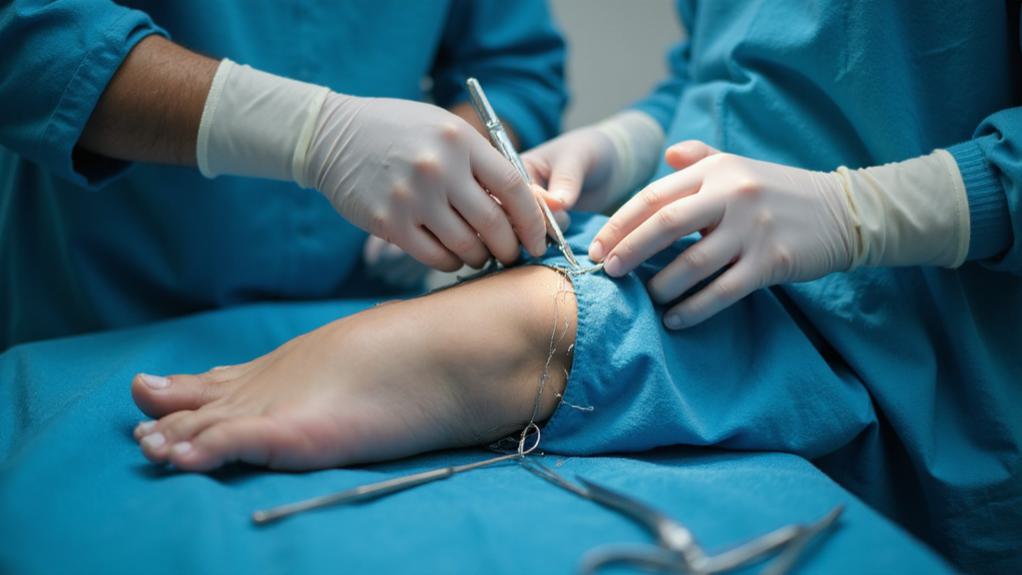إذا كنت تفكر في جراحة القدم والكاحل، ستجد أن هذا المجال المتخصص في الهند يتناول الظروف المعقدة-مثل الكسور الرضحية أو التهاب المفاصل التنكسي أو التشوهات الخلقية- مع التقنيات المتطورة مثل تنظير المفاصل والإجراءات طفيفة التوغل. تقرير الخبراء معدلات نجاح أعلى من 90%وغالباً ما يستشهدون بحالات دمج الكاحل لاستعادة الثبات. ومع ذلك، ما هي العوامل التي تحدد أفضل نهج لحالتك الفريدة؟ قد يكشف استكشاف هذا الأمر بشكل أكبر عن رؤى مهمة لاتخاذ قرارك.
الوجبات الرئيسية
- تعالج جراحة القدم والكاحل الصدمات والتهاب المفاصل والتشوهات باستخدام تقنيات طفيفة التوغل أو مفتوحة.
- تشمل الإجراءات الشائعة دمج الكاحل واستبداله واستئصال الوكعة وإصلاح الأوتار للحصول على راحة دائمة.
- في الهند، تتراوح التكاليف بين 2,000 و5,000 دولار أمريكي، مما يوفر رعاية عالمية المستوى وبأسعار معقولة.
- يتراوح التعافي من 6 أسابيع إلى شهور، مع وجود علاج طبيعي يساعد على أداء الوظائف.
- تشمل المخاطر الإصابة بالعدوى وتلف الأعصاب، على الرغم من أن معدلات النجاح غالباً ما تتجاوز 90%.
مجال جراحة القدم والكاحل، وهو تخصص فرعي أساسي بشكل متزايد داخل جراحة العظامشهدت النمو الملحوظ في الهندالتي تضع نفسها على أنها المجال الأسرع تطوراً في هذا التخصص، كما يتضح من توسيع نطاق العضوية للجمعية الهندية للقدم والكاحل (IFAS). أثناء استكشافك لهذا المجال المتخصص، ستلاحظ أن زيادة في الاهتمام من بين الأخصائيون الطبيونإلى جانب العدد المتزايد من مراكز تدريب مخصصةيؤكد على أن التحول المحوري في كيفية حالات القدم والكاحل وعلاجها في البلاد. فبينما كان هناك ندرة في الوعي، سواء بين الجمهور أو داخل الوسط الطبي، تجد الآن اعترافاً متزايداً بأهمية معالجة هذه المشاكل التي غالباً ما تكون منهكة بدقة وخبرة.
عندما تستكشف مشهد التطورات الجراحية، يتضح لك أن اعتماد التقنيات طفيفة التوغل الجراحيعلى الرغم من عدم انتشارها في كل مكان بعد، إلا أنها تكتسب زخمًا بين الجراحين الهنود. من المحتمل أن تصادف محترفين يصقلون مهاراتهم في طرق تنظير المفاصلوالتي تسمح بتصحيح مجموعة واسعة من الأمراض مع تقليل أوقات التعافي. ضع في اعتبارك، على سبيل المثال، الإجراءات الروتينية التي قد تلاحظها، مثل تصحيح التشوهات الناشئة عن الخلل الوظيفي في الظنبوب الخلفي أو علاج تشوه هاغلوند و إبهام إبهام القدم الأروحوكلها تعكس النطاق المتسع للتدخلات المتاحة لمعالجة أمراض القدم والكاحل المعقدة. بالإضافة إلى ذلك، توفر مصادر مثل مجلة *التقنيات في جراحة القدم والكاحل* رؤى قيمة حول الأساليب الجراحية، وتقدم إرشادات مفصلة حول الأساس المنطقي والمزالق لمختلف الإجراءات. وعلاوة على ذلك، فإن النصوص الشاملة مثل *التقنيات الجراحية في جراحة القدم والكاحل* لمارك إي إ. إيزلي دكتوراه في الطب تقدم توضيحات متعمقة خطوة بخطوة ورؤى الخبراء ل إتقان التقنيات الجراحية.
وعلاوة على ذلك، ستكتشف، وأنت تتحرى التحديات في هذا المجال، مشكلة مستمرة تتمثل في الإصابات المهملة التي، إذا أسيئت إدارتها، غالبًا ما تتطور إلى حالات مزمنة تتطلب تدخلات معقدة. وعلى الرغم من إنشاء مراكز الامتياز منذ عام 2006، يجب أن تعترف بالقيود التاريخية للاستدامة المالية وتوافر الموارد التي أعاقت الرعاية الشاملة. ومع ذلك، ومع المبادرات الأخيرة في إطار حملة "اصنع في الهند"، فإنك تشهد تحسينات في الوصول إلى الغرسات والأدوات المهمة، وهو تطور يعد بتعزيز النتائج الجراحية. بينما تتأملون في هذه التطورات، من الواضح أن مسار جراحة القدم والكاحل في الهند، مدفوعاً بتعزيز التدريب والبنية التحتية، يقدم سرداً مقنعاً للتقدم والإمكانات للملتزمين بهذا التخصص الفرعي الأساسي في جراحة العظام.
لمحة عامة
تشمل جراحة القدم والكاحل مجموعة من الإجراءات التي تهدف إلى معالجة مختلف الحالات والإصابات التي تؤثر على هذه الهياكل الحساسة الحاملة للوزن. تشمل المشكلات الشائعة التي تستلزم الجراحة ما يلي الصدمة مثل الكسور والخلع، والحالات التنكسية مثل التهاب المفاصل، التشوهات الهيكلية بما في ذلك الأورام وأصابع القدم المطرقة, إصابات الأوتار أو تمزقهاوالالتهابات الشديدة مثل التهاب العظم والنقي. تتنوع خيارات العلاج حسب الحالة المحددة وشدتها، وتتراوح بين التقنيات طفيفة التوغل مثل تنظير المفاصل وجراحة ثقب المفتاح إلى الجراحة المفتوحة التقليدية للحالات الأكثر تعقيدًا. يتم تصميم إجراءات مثل دمج الكاحل واستبدال الكاحل واستئصال الوكعة وتصحيح إصبع القدم المطرقية وإصلاح الأوتار لاستعادة الوظيفة أو تخفيف الألم أو تصحيح التشوهات. عادةً ما يوصى بهذه العمليات الجراحية للأفراد الذين لم يستجيبوا للعلاجات التحفظية مثل العلاج الطبيعي أو الأدوية، أو للأفراد الذين يعانون من إصابات حادة تتطلب تدخلاً فورياً لمنع حدوث مضاعفات أو إعاقة طويلة الأمد. غالبًا ما يعتمد قرار الخضوع للجراحة على ما يلي شدة الأعراضبما في ذلك الألم والتأثير على الحياة اليومية. في المراكز المتخصصة مثل Mayo Clinic (مايو كلينك)، يستفيد المرضى من رعاية فردية يقدمها جرّاحون مدربون على مستوى الزمالة يعالجون مشاكل القدم والكاحل الشائعة والمعقدة على حد سواء.
تفاصيل العلاج والمعلومات الأساسية
جراحات القدم والكاحل في الهندلا سيما في مستشفيات الشركات الرائدةمرغوبة بشدة من قبل المرضى الأجانب بسبب مرافق عالمية المستوى, الجراحين ذوي الخبرةو علاجات فعالة من حيث التكلفة. تقدم هذه المستشفيات مجموعة من الإجراءات بما في ذلك التحام الكاحلاستبدال الكاحل (رأب المفصل), إصلاح وتر العرقوبوجراحة الوكعة وترميم القدمين وترميم القدمين، وتلبية حالات مثل التهاب المفاصل والتشوهات والإصابات. تتراوح مدة الإقامة بالمستشفى عادةً من يوم إلى يومين، حسب مدى تعقيد الجراحة، بينما تتراوح مدة الإقامة الكلية وقت التعافي من 6 أسابيع إلى عدة أشهر، وغالبًا ما تتطلب علاجًا طبيعيًا وتعديل النشاط. تختلف أوقات إجراء العمليات الجراحية بناءً على نوع الجراحة، حيث تستغرق التقنيات طفيفة التوغل مثل تنظير المفاصل حوالي ساعة إلى ساعتين أو ساعتين، بينما تستغرق العمليات الجراحية المفتوحة الأكثر تعقيداً أو عمليات إعادة البناء من ساعتين إلى أربع ساعات. توفر المستشفيات في الهند كلاً من بمساعدة الروبوت وغير الروبوتية (التقليدية أو طفيفة التوغل)؛ حيث توفر الجراحات الروبوتية دقة أكبر وشفاء أسرع ولكنها أكثر تكلفة، في حين أن الطرق غير الروبوتية، بما في ذلك الجراحة المفتوحة، متاحة على نطاق أوسع وفعالة من حيث التكلفة ولكنها قد تنطوي على فترة نقاهة أطول ومخاطر أعلى من الندبات. لكل نهج إيجابياته وسلبياته، حيث تقلل الخيارات الروبوتية من الأخطاء البشرية ولكنها تتطلب معدات متخصصة، في حين أن الطرق التقليدية قد تكون أكثر ملاءمة لبعض الحالات المعقدة على الرغم من زيادة التوغل. بالإضافة إلى ذلك، غالبًا ما تعالج جراحات الكاحل الحالات الشديدة التي تفشل فيها العلاجات غير الجراحية، مما يوفر تسكين الآلام وتحسين الوظيفة. على سبيل المثال، صُممت إجراءات مثل إيثاق مفصل الكاحل لدمج العظام معًا، مما يوفر حلاً دائمًا ل التخلص من حركة المفاصل وتخفيف الآلام المزمنة.
الفوائد والمزايا الرئيسية
لقد برزت جراحة القدم والكاحل في الهند كخيار مفضل للمرضى في جميع أنحاء العالم بسبب الجمع بين الرعاية عالية الجودة والتقنيات المتقدمة والقدرة على تحمل التكاليف. تفتخر البلاد بمعدل نجاح مرتفع لهذه العمليات الجراحية، وغالباً ما يتجاوز 90%، وذلك بفضل الجراحين المهرة المدربين على الأساليب طفيفة التوغل واستخدام أحدث المعدات. تعالج هذه الإجراءات بفعالية حالات مثل التهاب المفاصل وعدم الاستقرار المزمن والتشوهات، مما يوفر تقليل الألم وتحسين الأداء الوظيفي وسرعة التعافي. وبالإضافة إلى ذلك، توفر الهند خطط رعاية شخصية وخيارات تعافي محسّنة، مثل الجوارب الضاغطة والتحريك المبكر، مما يضمن نتائج مثالية. إن تقليل خطر الإصابة بالعدوى والقدرة على العودة إلى الأنشطة اليومية بشكل أسرع يجعل هذا العلاج خياراً مقنعاً للمرضى المحليين والدوليين الذين يسعون إلى الراحة طويلة الأمد والتصحيحات الهيكلية.
| البلد | متوسط تكلفة جراحة القدم والكاحل (بالدولار الأمريكي) | ملاحظات القدرة على تحمل التكاليف |
|---|---|---|
| الهند | 2,000 – 5,000 | أسعار معقولة للغاية مع مرافق ذات مستوى عالمي. |
| الولايات المتحدة الأمريكية | 10,000 – 30,000 | باهظة الثمن بسبب ارتفاع تكاليف الرعاية الصحية. |
| المملكة المتحدة | 8,000 – 15,000 | باهظة الثمن إلى حد ما مع فترات انتظار طويلة. |
| سنغافورة | 6,000 – 12,000 | أكثر تكلفة من الهند ولكنها تقدم رعاية متميزة. |
| تايلاند | 3,000 – 7,000 | بأسعار معقولة، وإن كانت أعلى قليلاً من الهند. |
عملية العلاج
عملية العلاج لـ جراحة القدم والكاحل تبدأ بـ تقييم شامل للتحقق من أن المريض مرشح مناسب لإجراء العملية. الإجراءات التشخيصيةمثل الأشعة السينية أو التصوير بالرنين المغناطيسي أو الأشعة المقطعيةلتقييم مدى الإصابة أو الحالة المرضية، حيث يتم إجراء صور مفصلة للعظام والمفاصل والأنسجة الرخوة. يتم إجراء تقييم المخاطر تقييم الحالة الصحية العامة للمريض، في حين أن مراجعة الأدوية يؤكد أن الوصفات الطبية الحالية آمنة للاستمرار أثناء الجراحة. تحضيرات ما قبل الجراحة تتضمن تعليمات مفصلة عن الصيام وتعديلات الأدوية والخطوات الضرورية الأخرى، إلى جانب الحصول على موافقة مستنيرة للتأكد من فهم المريض الكامل للإجراء والمخاطر المرتبطة به. بمجرد اكتمال هذه الخطوات، يتم إجراء النهج الجراحي-سواءً كانت الجراحة المفتوحة ذات الشقوق الكبيرة أو التقنيات طفيفة التوغل مثل تنظير المفاصل أو جراحة ثقب المفتاح، فهي مصممة خصيصاً للحالة المرضية المحددة، مثل دمج الكاحل أو تصحيح ورم الكاحل أو إصلاح الكسور باستخدام الصفائح والبراغي. هذا التحضير الدقيق والتخطيط الدقيق أمر بالغ الأهمية لتحقيق نتيجة ناجحة وتقليل المضاعفات.
النتائج المتوقعة
يمكن أن تسفر جراحة القدم والكاحل عن مجموعة من النتائج اعتمادًا على الإجراء المحدد والعوامل الفردية للمريض. في قصير الأجل، يمكن أن يتوقع المرضى ألم ما بعد الجراحة مباشرةوالتي عادة ما يتم التعامل معها بالأدوية، إلى جانب الآثار الجانبية الشائعة مثل التورم والتصلب. على المدى الطويل، يحقق معظم المرضى وظيفة شبه طبيعية في غضون عام إلى عامين، مع تحسن ملحوظ في المشي والتوازن غالبًا ما يظهر في غضون ستة أشهر، شريطة الالتزام العلاج الطبيعي ورعاية المتابعة. ومع ذلك، قد تتطلب الفعالية على المدى الطويل إجراء تعديلات في نمط الحياة، مثل تجنب الأنشطة عالية التأثير وارتداء أحذية داعمة للحفاظ على النتائج. المخاطر والمضاعفاتبما في ذلك تلف الأعصاب والعدوى والتخثر الوريدي العميق (DVT) والمحاذاة غير السليمة للعظام، يمكن أن تؤثر على النتائج، مع وجود علامات تحذيرية مثل الألم المستمر أو التورم الشديد أو الحمى التي تتطلب عناية فورية. تتفاوت معدلات النجاح حسب الإجراء والحالة، ولكن مع إعادة التأهيل المناسبة ونمط الحياة الصحي، يختبر العديد من المرضى تحسين جودة الحياة، على الرغم من أن القيود الوظيفية أو اضطرابات المشي قد تستمر لمدة تصل إلى عامين، خاصة بعد جراحة كسر الكاحل.
الرعاية اللاحقة للعلاج والتعافي
بعد الخضوع جراحة القدم والكاحلمناسب الرعاية بعد العلاج والتعافي أمران حيويان لتحقيق نتيجة ناجحة. تشمل المتطلبات الطبية لما بعد العلاج تناول الأدوية الموصوفة للألم لإدارة الانزعاج، والحضور بانتظام مواعيد المتابعة مع مقدمي الرعاية الصحية لمراقبة الشفاء، وبدء العلاج الطبيعي عادةً بعد أسبوعين إلى أربعة أسابيع بعد الجراحة لتحسين القوة ونطاق الحركة، مع إجراء جلسات مرتين إلى ثلاث مرات أسبوعيًا لمدة ستة إلى ثمانية أسابيع. تتضمن الاحتياطات اللازمة خلال مرحلة التعافي ما يلي يستريح للسماح للجسم بالشفاء، ووضع الثلج واستخدام الضمادات الضاغطة لتقليل التورم، ورفع القدم لتحسين تدفق الدم، ومراقبة الجرح عن كثب بحثًا عن علامات العدوى مثل الاحمرار أو زيادة الألم. تغييرات في نمط الحياة من الضروري أيضًا، بما في ذلك تقليل الأنشطة المرهقة للوقاية من المضاعفات، والحفاظ على نظام غذائي متوازن والحفاظ على رطوبة الجسم لدعم الشفاء، ورفع الطرف المصاب حتى أثناء النوم، وطلب الدعم النفسي من خلال خطوط المساعدة أو المجموعات إذا لزم الأمر لمعالجة الحالة النفسية أثناء التعافي.
المراجع
- https://shop.lww.com/Techniques-in-Foot—Ankle-Surgery/p/1538-1943
- https://shop.lww.com/Operative-Techniques-in-Foot-and-Ankle-Surgery/p/9781975173890
- https://www.jfasap.com/doi/JFASAP/pdf/10.5005/jp-journals-10040-1259
- https://www.wolterskluwer.com/en/solutions/ovid/techniques-in-foot–ankle-surgery-1130
- https://pmc.ncbi.nlm.nih.gov/articles/PMC7093617/
- https://versusarthritis.org/about-arthritis/treatments/surgery/foot-and-ankle-surgery/
- https://www.mayoclinic.org/medical-professionals/orthopedic-surgery/news/foot-and-ankle-surgery-helping-patients-reach-their-goals/mac-20470434
- https://www.wmchealth.org/service-line/orthopedics/orthopedic-surgery/foot-and-ankle-surgery
- https://www.medstarhealth.org/services/foot-surgery-and-ankle-surgery
- https://www.thepodiatrygroup.com/2023/08/25/how-does-foot-ankle-surgery-work/
- https://my.clevelandclinic.org/health/treatments/21047-ankle-surgery
- https://www.drgarydriver.com/foot-and-ankle-procedures/
- https://www.riversideonline.com/en/patients-and-visitors/healthy-you-blog/blog/t/top-10-foot-and-ankle-surgeries
- https://www.advancedosm.com/complex-foot-ankle-surgeries-orthopaedic-sports-medicine-specialist-cypress-houston-tx/
- https://www.faicolorado.com/blog/reasons-you-may-need-foot-and-ankle-surgery
- https://www.jawspodiatry.com/benefits-of-minimally-invasive-foot-and-ankle-surgery/
- https://absolutefootanklespecialists.com/blog/item/302-the-benefits-of-having-foot-surgery-performed.html
- https://thcboneandjoint.com/what-hurts/foot-ankle/minimally-invasive-foot-ankle-surgery.html
- https://www.hopkinsmedicine.org/health/treatment-tests-and-therapies/foot-and-ankle-surgery
- https://www.mayoclinic.org/tests-procedures/ankle-surgery/about/pac-20385132

